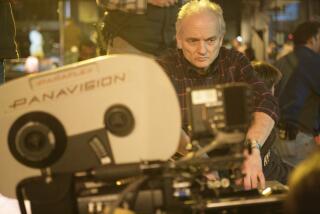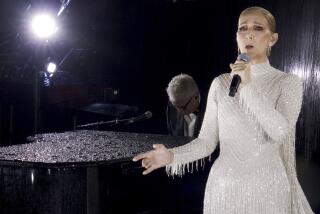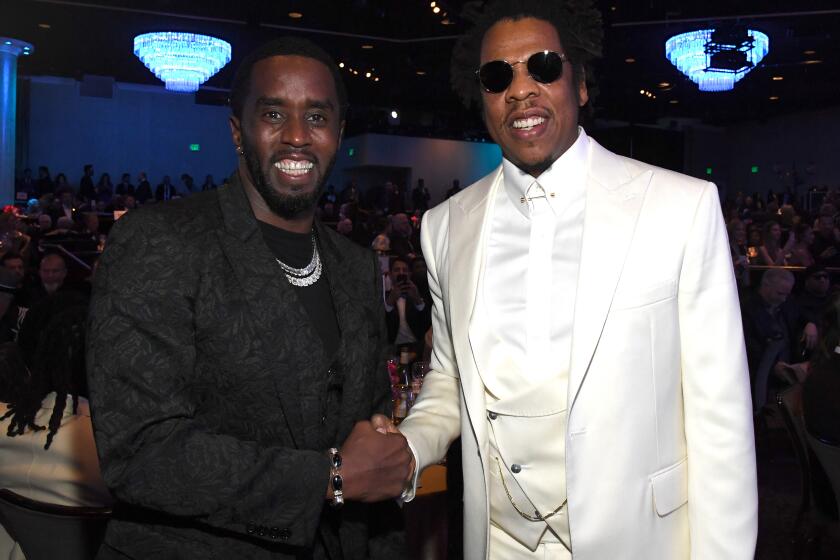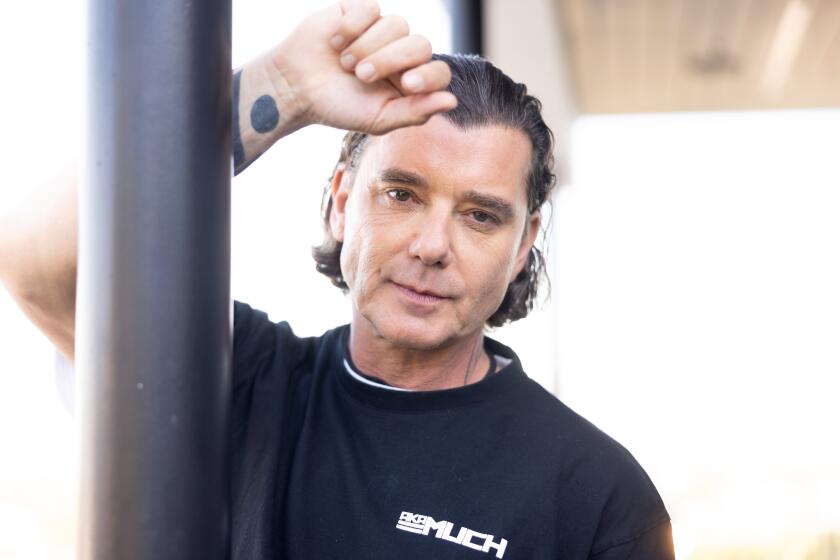Going beyond Journey’s end with ‘Don’t Stop Believin’ ’
- Share via
There’s an old pop aphorism that goes: “Don’t bore us -- get to the chorus.” By that yardstick, Journey’s “Don’t Stop Believin’ ” should be one of the most boring and unsuccessful rock recordings of all time.
Structurally, it’s a mess: Surely one would get tossed out of songwriting school for a tune that follows its opening piano riff with a verse, a guitar arpeggio, a second verse, a bridge, a guitar solo, a third verse, a repeat of the bridge, another guitar solo . . . and then, 3 minutes, 20 seconds in, when the song is ready to fade out, one of the most unforgettable choruses in rock.
Is it any wonder “Don’t Stop Believin’ ” stalled at a just-OK No. 9 when it was released in 1981?
Somehow, though, the song has escaped damning evaluations and footnote status to become our arena-rock national anthem, universally beloved not just by karaoke bar owners but competing Midwestern sports franchises, Hollywood movie and TV music supervisors, Great White Way theater doyennes and New Jersey mobsters enjoying their final meals.
Its use in the famous last episode of “The Sopranos” (2007) was so definitive that you might have thought any future soundtrack appearances, at least unironic ones, had been whacked. Yet it is still played for purposes of sincere inspiration too, offering a self-contained climax to Fox’s pilot of the new series “Glee” or Broadway’s “Rock of Ages.”
Journey’s keyboard player, Jonathan Cain, doesn’t credit “Sopranos” creator David Chase with the revival. He credits Adam Sandler -- he knew something was up when the song provided a laugh in 1998’s “The Wedding Singer.”
“Adam Sandler didn’t actually sing it, but there was this little string quartet playing it, and that was the beginning. Who knew?” Cain said.
Those strings might have been going for nostalgic chuckles, but few other uses of the song have -- least of all sports teams such as the Chicago White Sox, who adopted it as their theme for the 2005 World Series. Multiple Detroit franchises employ it because of the lyrical mention of “south Detroit” (even though most Michigan natives contend there is no such place). The entire crop of “Idol” contestants sang it on a 2009 results show. TV dramas “Cold Case” and “CSI” bring it out as a cultural reference point. Performers not known for their sense of irony, from Martina McBride to Kanye West, have earnestly encored with it on tour.
Cain says he had just signed on with Journey when he, singer Steve Perry and guitarist Neil Schon co-wrote the song. “I had the title and the last chorus, so I brought it in, and we worked backward. That was one of those great days to be in a band,” he says.
“There is an odd form to the song as well, because it’s almost like an A-B-A-B-C pattern,” he says, perhaps understating the true nuttiness of the song’s structure. “So there’s that chorus they hadn’t heard before at the end. But we knew we wanted to save it. It’s like a wave about to happen -- the anticipation of something happening, a change in your life,” Cain said
That sense of tension and eventual anthemic release may have given the song more staying power than a song that gives away all its goods in the first minute.
“Don’t Stop Believin’ ” has become the top-selling digital download of a track not originally released in this century, selling 2,803,000 units since online single sales began to be tracked in 2003, according to Nielsen SoundScan.
--
Crossover power
And apparently there’s room in people’s hearts to hear a full chorale bust out that chorus too. The “Glee” cast’s version debuted at No. 2 on the iTunes chart, with 302,000 downloads of its own.
Most recently, the song solved the annual problem of how to keep a Middle American audience tuned in for a few minutes of the Tony Awards, as the bewigged cast of “Rock of Ages,” the ‘80s jukebox musical, fronted for the occasion by “Idol” also-ran Constantine Maroulis, got some audience members to flick their Bics.
“Talk about just creating tension -- it just builds and builds, all the way up until the very end,” says “Rock of Ages” writer-producer Chris D’Arienzo. “That song really is just kind of a big freight train. We had several mix CDs of ‘80s arena-rock songs we wanted to use in the show, and it felt clear to me from the beginning that it had to be our 11 o’clock number.”
D’Arienzo places “Don’t Stop Believin’ ” in a rock tradition peculiar to the era of Ronald Reagan and “Rocky” sequels: the power riff-laden pep talk.
“There’s this whole genre of inspirational rock that you really didn’t see a lot before or after the ‘80s. It was tied into movies, especially: You had ‘Eye of the Tiger,’ ‘Fame,’ ‘Holding Out for a Hero’ -- the go-get-’em-champ kind of tunes that are hard to deny,” he said. “Even the worst ones are kind of fun, and ‘Don’t Stop Believin’ ’ just happens to be the very best.”
“One thing that song does is it rises to the occasion,” says Journey’s Cain, who says the verses were inspired by his time observing lonely wannabes hooking up on the Sunset Strip in the 1970s. “It amazes me, on a dark thing like ‘The Sopranos,’ that all of a sudden, some of those lyrics take on a different meaning. ‘Some will win, some will lose / Some are born to sing the blues’ -- if that’s not Tony, I don’t know who it is. And yet you can go to a teen show like ‘Glee,’ and it’s this bubbly thing.”
Cain recalls his father bucking him up when he was a young struggling musician in his pre-Journey 1970s band, the Babys. “I was always starving, and I’d call him up and he’d say, ‘Don’t stop believing or you’re done, dude.’ ”
Journey had bigger smashes such as “Who’s Crying Now” and “Open Arms,” then broke up in ‘86, reunited for one album with the increasingly reclusive Perry in ’96 and has been recording and touring with other singers since. It was on those late-’90s tours that Cain noticed the song had surpassed the others in their catalog in prompting a rush to the stage.
The meaning behind David Chase’s selection of the song for the final moments of “The Sopranos” -- and, presumably, the lead character’s life -- remains a Rorschach test for people who watched the show. Was it just because that’s what a New Jersey guy in his late 40s would order up with his onion rings in a diner? Or, given the artsier leanings of almost all the other rock used on the series, did Chase pick a commercial hit to make some banality-of-evil statement about Tony’s life? Or was it the song’s tension and buildup, which worked wonders in tandem with the unbearable tension and buildup of Meadow Soprano’s parallel parking?
“I can’t hear it now without flashing on ‘The Sopranos,’ so I wish other shows would stop using it,” said Gregg Kilday, movie editor of the Hollywood Reporter. “Every time, I keep waiting for the slam to black.”
--
The feel-good factor
“Glee” producer Brad Falchuk admits that some viewers might hear the familiar opening piano riff and initially assume the song is being played for irony, but he maintains uplift was the only thing on their minds.
“Some songs like that move into cliche and then move through cliche into some iconographic thing where they can be interpreted so many different ways,” Falchuk says. “But for ‘Glee’ we were really going for the most basic form of it -- whittling it down to its pure feel-good essence. It’s not one of those songs you feel is too cheesy. You can sing to it in karaoke and not feel silly. When we screened the pilot for people, we knew we were doing something right when a lot of people were sort of choked up at the end of that number.”
D’Arienzo, of “Rock of Ages,” says there’s a reason the tune inevitably gets used as a finale -- be it “The Sopranos,” “Glee,” his Broadway show, or the upcoming “American Idol” tour.
“It’s a song that does a lot of heavy lifting for whoever uses it,” he says. “I don’t kid myself that it isn’t why people are on their feet at the end of our show. When ‘Sopranos’ happened and ‘Glee’ happened, there’s a part of you that thinks, ‘Oh, shoot, we had it first!’ But it never occurred to me that we should not use it, because it’s irreplaceable as a perfect ending song.”
He believes that Americans’ attitude toward the song is essentially . . . don’t stop.
--
More to Read
The biggest entertainment stories
Get our big stories about Hollywood, film, television, music, arts, culture and more right in your inbox as soon as they publish.
You may occasionally receive promotional content from the Los Angeles Times.










